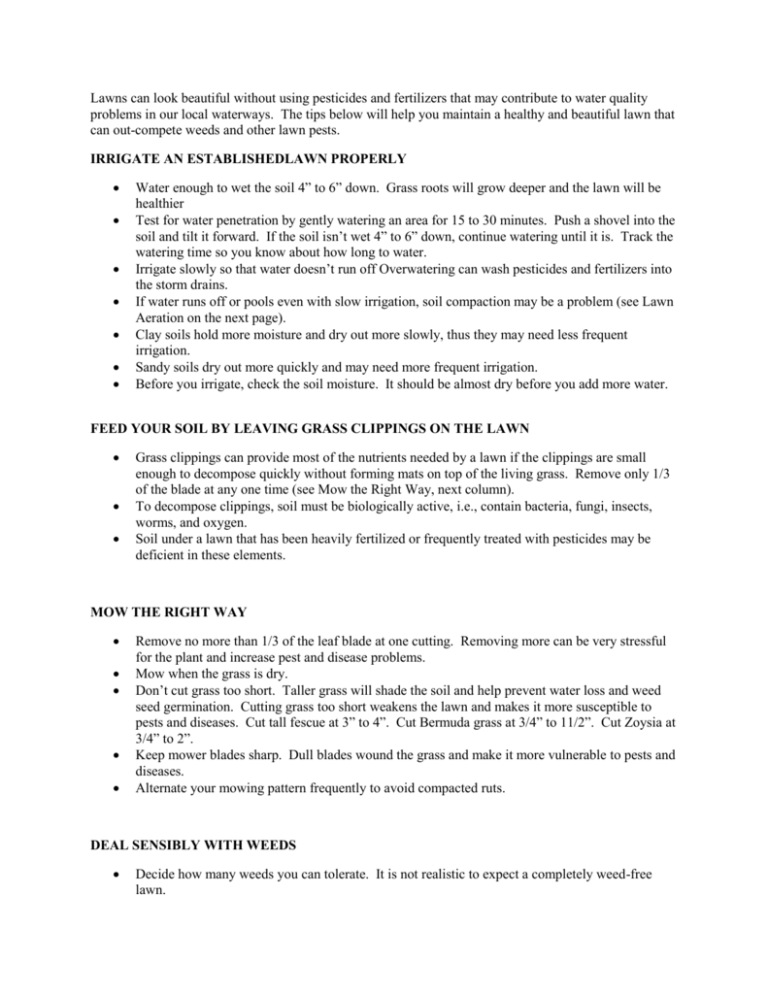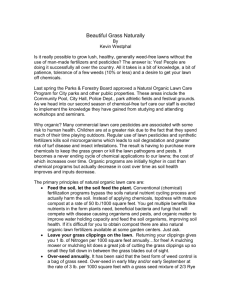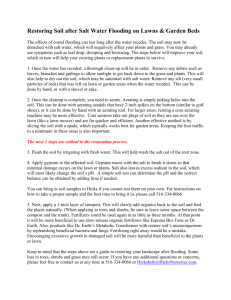Click here - Absolute Hydroseeding
advertisement

Lawns can look beautiful without using pesticides and fertilizers that may contribute to water quality problems in our local waterways. The tips below will help you maintain a healthy and beautiful lawn that can out-compete weeds and other lawn pests. IRRIGATE AN ESTABLISHEDLAWN PROPERLY Water enough to wet the soil 4” to 6” down. Grass roots will grow deeper and the lawn will be healthier Test for water penetration by gently watering an area for 15 to 30 minutes. Push a shovel into the soil and tilt it forward. If the soil isn’t wet 4” to 6” down, continue watering until it is. Track the watering time so you know about how long to water. Irrigate slowly so that water doesn’t run off Overwatering can wash pesticides and fertilizers into the storm drains. If water runs off or pools even with slow irrigation, soil compaction may be a problem (see Lawn Aeration on the next page). Clay soils hold more moisture and dry out more slowly, thus they may need less frequent irrigation. Sandy soils dry out more quickly and may need more frequent irrigation. Before you irrigate, check the soil moisture. It should be almost dry before you add more water. FEED YOUR SOIL BY LEAVING GRASS CLIPPINGS ON THE LAWN Grass clippings can provide most of the nutrients needed by a lawn if the clippings are small enough to decompose quickly without forming mats on top of the living grass. Remove only 1/3 of the blade at any one time (see Mow the Right Way, next column). To decompose clippings, soil must be biologically active, i.e., contain bacteria, fungi, insects, worms, and oxygen. Soil under a lawn that has been heavily fertilized or frequently treated with pesticides may be deficient in these elements. MOW THE RIGHT WAY Remove no more than 1/3 of the leaf blade at one cutting. Removing more can be very stressful for the plant and increase pest and disease problems. Mow when the grass is dry. Don’t cut grass too short. Taller grass will shade the soil and help prevent water loss and weed seed germination. Cutting grass too short weakens the lawn and makes it more susceptible to pests and diseases. Cut tall fescue at 3” to 4”. Cut Bermuda grass at 3/4” to 11/2”. Cut Zoysia at 3/4” to 2”. Keep mower blades sharp. Dull blades wound the grass and make it more vulnerable to pests and diseases. Alternate your mowing pattern frequently to avoid compacted ruts. DEAL SENSIBLY WITH WEEDS Decide how many weeds you can tolerate. It is not realistic to expect a completely weed-free lawn. Dig up weeds by hand and sprinkle grass seed on any bare spots so weeds can’t fill in. Water regularly with a fine spray until the grass sprouts. Keep grass growing vigorously to crowd out weeds. Don't mow grass too short; taller blades can shade the soil enough to prevent some weed seeds from germinating. Use corn gluten meal to prevent certain broadleaf weeds from germinating. Apply in spring or fall a few weeks before annual weeds begin to germinate. LAWN AERATION Aerate spots where you can’t push a screwdriver 6” into the soil, where water pools, where grass looks thin, or where there is heavy traffic. Use a hollow-timed aerator that removes plugs of soil, either a foot-operated or motorized model. Irrigate deeply (soil should be moist 6” down) so you can push the aerator into the soil as far as possible. Allow soil to dry slightly before you begin. Leave the plugs on the lawn and break them up with a garden rake. DETHATCHING LAWNS Thatch is dead and dying, matted grass parts that accumulate on top of the soil. Thatch prevents air, water, and fertilizer from reaching the soil. Remove thatch with a rake or dethatching machine if more than 1/2" thick. Aeration (see above) can help prevent thatch buildup. When soil is biologically active, grass clippings decompose and do not contribute to thatch buildup. This is a good reason to minimize or eliminate the use of broad-spectrum pesticides. FERTILIZING Lawn fertilizers contain a large amount of nitrogen and smaller amounts of other nutrients. Some nitrogen may be needed to maintain good lawn color and density, but applying too much nitrogen promotes excessive growth and makes a lawn more susceptible to pests and disease. Unless the soil texture is sandy, nutrient deficiencies are unlikely and you may not need to fertilize at all. If in doubt, have your soil professionally tested. Grass clippings left on the lawn can provide most of the fertilizer. If you need to fertilize, use natural fertilizers or slow-release fertilizers, such as sulfur- or polymer-coated urea. These products release nutri-ents slowly over a longer period, allowing the grass to absorb nutrients more efficiently. The best times to fertilize tall fescue lawns are March, May, October and November. Fertilize sparingly or not at all during hot summer weather. The best times to fertilize Bermuda grass and Zoysia are April, May, September and October. Do not fertilize in winter when these grasses are dormant. PLANTING A NEW LAWN – START OUT RIGHT Have your soil professionally tested so you know the texture, pH, and salt and nutrient levels. (Preferred Grasses for California). Choose pest- and disease-resistant varieties (ask your nursery). Choose sod that has been propagated in soil similar to your own. PREPARE THE SOIL BEFORE INSTALLING A NEW LAWN Don’t work the soil when it is very wet. You can damage its structure. Thoroughly mix soil layers of different textures before planting. Poor soil preparation can cause poor drainage resulting in weak turf. Break up all clods into fine particles and remove pebbles and stones. Check for low spots by irrigating. Smooth out areas where you see puddles (very important if you are seeding a lawn). IRRIGATE A NEW LAWN Be sure to keep the soil under a new lawn thoroughly moist until the lawn becomes established, but don’t drown the plants. Too much water can also wash away seeds.





